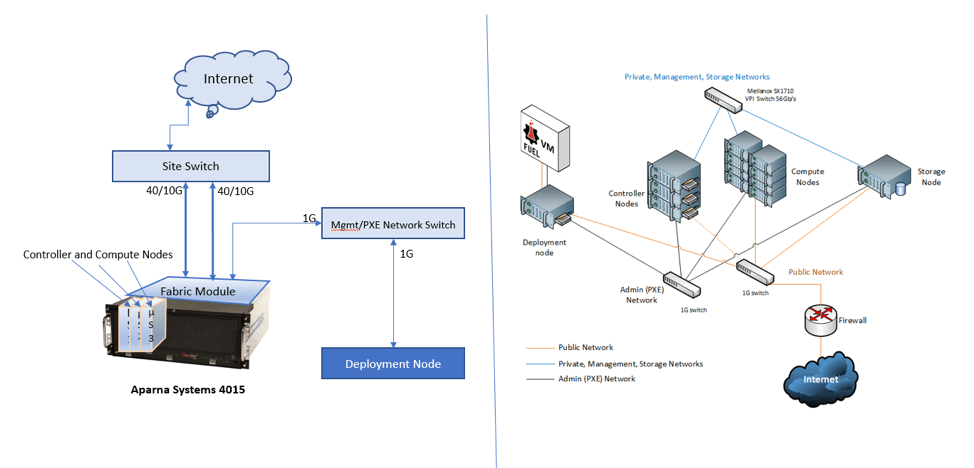Virtualization
Deployment of OpenStack using CableLabs’ SNAPS on Aparna µCloud 4015

OpenStack software controls large pools of compute, storage and networking resources throughout a datacenter, managed through a dashboard or via the OpenStack API. OpenStack works with popular enterprise and open source technologies making it ideal for heterogeneous infrastructure and it is a popular platform for service providers to run their NFV software. Given the large number of services provided by OpenStack, the deployment methods can be complex—even with excellent documentation provided by the OpenStack consortium.
SNAPS from CableLabs
To reduce the complexity of deployment of OpenStack, CableLabs introduced a set of scripts and a process called SNAPS and has placed these resources in an open source domain. SNAPS allows any organization to deploy a release of OpenStack on a set of compute, storage and network devices with two scripts/processes—as long as these devices meet OpenStack’s minimal requirements.
SNAPS OpenStack deployment scripts involve downloading the latest source/scripts from CableLabs’ GitHub repository and making modifications to a well-documented YAML file that provides details about the controller and compute nodes along with networking information:
- The SNAPS Boot—This document specifies the steps and configuration required for OS provisioning of bare metal machines via SNAPS boot.
- The OpenStack Distribution Deployment—This document specifies the steps and configuration required for OpenStack installation on servers configured by SNAPS Boot.
Aparna Systems’ µCloud 4015
Ideal for SNAPS OpenStack deployment, Aparna Systems’ µCloud 4015 (Micro Cloud)[1] is an ultra-converged, open, compact and high-density hardware platform consisting of compute, storage and network devices ideally suited for deployment at the edge of the network. A µCloud 4015 system:
- Can host up to 15 Intel Xeon (8, 12 or 16 core) µServers with attached storage for two SATA/NVME SSD drives
- Includes the provision of two fabric modules to provide connectivity between µServers as well as to the outside world
To demonstrate the advantages that an integrated and converged system such as the µCloud 4015 can provide, Figure 1 shows Aparna Systems deployment configurations in contrast withed with discrete servers.

Figure 1: Comparison of Ultra-Converged µCloud 4015 System vs. Discrete Component System
In a system with discrete servers, switches and storage modules, setting up interconnections and managing a fresh installation (as well as any additions to the system) can take significant time. By contrast, the number of connections that the µCloud 4015 requires are merely those needed for the network: two for OpenStack data and management networks and two for the fabric management port and preboot execution environment (PXE) network.
Hardware Requirements of OpenStack Installation Using SNAPS
Any OpenStack installation requires servers running as controller, compute and storage nodes (called host nodes), switches to connect these nodes as per the network requirements and a configuration/deployment node to manage the installation. All of these have certain minimum requirements (shown below).
Host Nodes
SNAPS OpenStack requires a minimum of three nodes for a basic configuration:
- One controller node and two compute nodes, each with at least 16 GB of memory
- 80 GB hard disk (or SSD)
- Two mandatory and one optional network interfaces
These nodes must be network boot enabled and Intelligent Platform Management Interface (IPMI) capable. Our test configuration includes three PXE boot enabled µServers, each with an Intel Xeon D1541 processor, 64 GB of memory and standard IPMI interfaces.
Networking
SNAPS OpenStack deployment requires three network interfaces: management, tenant and data. The tenant interface is an internal interface between the deployed nodes in the system and doesn’t require an external connection from the fabric module to the external world. However, the other two interfaces—management and data—must be connected to the external world.
Two 40G/10G ports of the fabric module are connected (either in the breakout mode or straight connection) to an external switch, which in turn lets the data and management interfaces be connected to the external world, as Figure 1 shows. The single-root I/O virtualization (SR-IOV) feature of the Intel Xeon D processors is used to create virtual interfaces from the single 10G interface to the fabric module of each of the µServers. PXE networking is enabled by using the fabric management (1G) network.
Configuration/Deployment/Build Node
According to the SNAPS guide, a server machine with 64bit Intel/AMD architecture with 16GB RAM and one network interface is required. This machine must be able to reach the host nodes via IPMI. An external machine matching or exceeding these criteria is used.
A µCloud 4015 can be used as a fully configured and prebuilt OpenStack system by using one of the µServers as a build/configuration node. This mode is also verified in the SNAPS OpenStack installation scripts.
SNAPS OpenStack Deployment—Adaptation Summary
To install OpenStack using SNAPS scripts, changes to the deployment process were necessary. However, one of the main criteria in using SNAPS scripts to deploy OpenStack is to avoid any system changes to the configuration/deployment node, as the same server could be used for different purposes in a lab environment. This has been achieved in Aparna Systems’ deployment by implementing all the changes and adding services on the fabric module of the µCloud 4015 system. These particular changes—including enabling BMC network access from an external configuration server and PXE boot changes—can be accessed on the CableLabs GitHub.
In addition, SR-IOV configuration changes are applied on each of the µServers to enable multiple virtual interfaces with a single physical 10G interface from the µServer to the fabric module. These are used in data, management and tenant networks of the OpenStack deployment.
Once SNAPS boot is completed, OpenStack deployment is achieved by modifying the “deployment.yaml” file with the IP addresses of the controller and compute nodes (and additional information), and running the script with appropriate parameters. This process is well documented at the SNAPS GitHub repository.
CableLabs Support Success
The support provided by the CableLabs team during this process has been immensely helpful in resolving issues that are specific to the µCloud 4015 deployment. The SNAPS team also gathered some valuable feedback from this adaptation exercise that could be useful for the enhancement of the scripts for future versions. Interested in learning more about the SNAPS platform in the future? Don't forget to subscribe to our blog or contact CableLabs Lead Architect Randy Levensalor.

[1] CableLabs does not endorse or certify the Aparna platform and similar platforms are available from other vendors.
--
The author, Ramana Vakkalagadda, is Director of Software Engineering at Aparna Systems.

